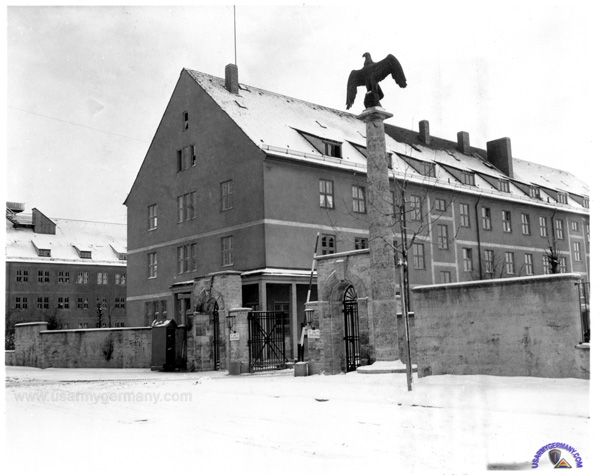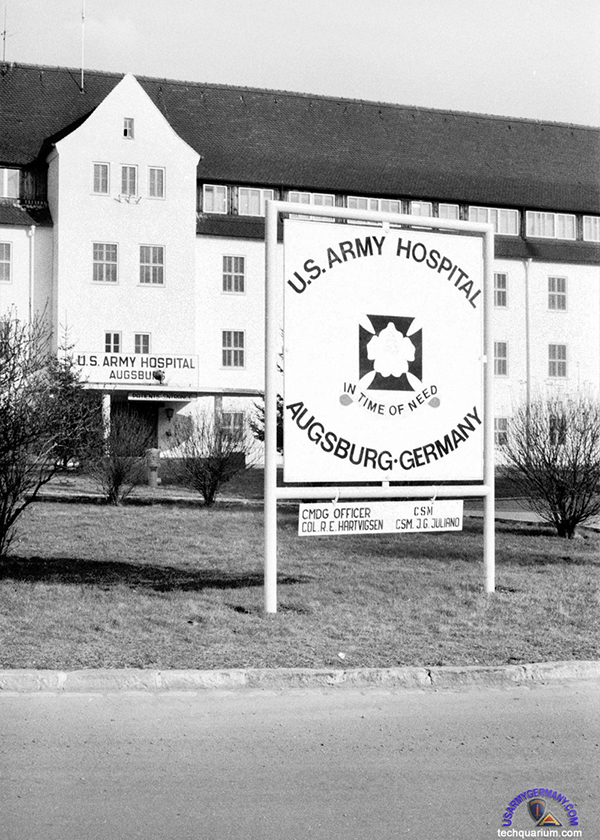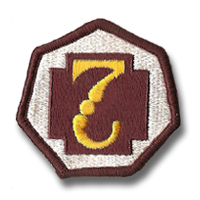| If you do
NOT see the Table of Contents frame to the left of this page, then
Click here to open 'USArmyGermany' frameset |
||||||||||||||||||||||
|
USAH
Augsburg |
||||||||||||||||||||||
|
|
||||||||||||||||||||||
|
||||||||||||||||||||||
|
|
||||||||||||||||||||||
|
||||||||||||||||||||||
| USAH Augsburg History | ||||||||||||||||||||||
|
||||||||||||||||||||||
 115th Station Hospital, General Kneussel Kaserne, Augsburg, c. 1946 |
||||||||||||||||||||||
 Main gate, 115th Station Hospital, Augsburg, 1945 |
||||||||||||||||||||||
| 1947 | ||||||||||||||||||||||
| (Source: EUCOM Medical Bulletin, July 1947) | ||||||||||||||||||||||
| The 115th Station Hospital was activated on 1 September 1942 at Camp Atterbury, Indiana, where it remained until 2 November 1942. On this date it moved to Fort Devens, Mass., where training was completed. The unit left the United States on 16 July 1943 and arrived in Scotland on 27 July 1943. It operated as a 750 -bed Station Hospital at Plaister Downs, South Devon, England,until the end of the European War.
In May of 1945 the personnel and equipment were moved to the continent and during August 1945 the movement to Augsburg was completed. The first patients were not received until November 1945, a much construction was necessary before the assigned kaserne was ready for the reception of patients. Subsequently the T/O and E was reduced to 250 beds and finally to 150 beds. The General Kneussl Kaserne, which the unit now occupies, was built in 1936. After the fall of Augsburg it was occupied by Headquarters, Seventh United States Army for a short time during the war. The site occupies about fifteen acres, with fourteen comparatively new buildings. in good repair. The conversion of the plant from an infantry kaserne to a hospital has been accomplished in a highly satisfactory manner. At the present time the facilities of the hospital have been consolidated so that the plant can be operated with a minimum of personnel. The actual treatment of patients has been confined to two buildings which house all wards, clinics, and out-patient services. All messes -- for enlisted personnel, patients, officers and nurses, and civilian personnel -- have been placed in one building. Quarters for Medical Department personnel are adequate and comfortable and are located within the kaserne, except those for male officers who occupy requisitioned billets near the hospital. |
||||||||||||||||||||||
| 1952 | ||||||||||||||||||||||
| (Source: USAREUR Medical Bulletin, February 1962, Vol. 19, No. 2) | ||||||||||||||||||||||
| In April 1952, the 11th Field Hospital occupied its new hospital plant at Flak Kaserne, Augsburg. | ||||||||||||||||||||||
 11th Field Hospital, Flak Kaserne, Augsburg, early 1960s |
||||||||||||||||||||||
| 1955 | ||||||||||||||||||||||
| (Source: USAREUR Medical Bulletin, November 1955) | ||||||||||||||||||||||
| Occupying a portion of Flak Casern, of headquarters of the Fifth Infantry Division, is the U. S. Army Hospital, Augsburg, operated by the 11th Field Hospital. It provides medical treatment to American servicemen and their families in and around historic Augsburg, which in the tenth century was the scene of a fierce battle between Germans of the region and invading Turks from the East. The casern was occupied by the German Luftwaffe during World War II, being used primarily as an anti-aircraft center. Present commanding officer of the hospital is Colonel William A. Todd, Jr., MC. |
||||||||||||||||||||||
| 1962 | ||||||||||||||||||||||
| (Source: USAREUR Medical Bulletin, February 1962, Vol. 19, No. 2) | ||||||||||||||||||||||
| Golden Augusta Vindelicorum, ancient Roman city, stronghold of Merchant Princes, birthplace of the Diesel and Messerschmitt, capital of Swabia, shrine of Lutheranism, is the home of the United States Army Hospital, Augsburg, and Headquarters of the Augsburg Medical Service Area. The operating unit is the 11th Field Hospital, which celebrated its tenth anniversary in beautiful Augsburg on 1 September 1961.
The Augsburg Medical Service Area encompasses ancient Swabia, now a part of Bavaria. Other military medical units include the 769th Medical Detachment (DS), 22d Medical Detachment, and one hospitalization unit of the 16th Field Hospital. The 769th Medical Detachment operates five dental clinics. It is commanded by Colonel John C. Kepper, DC, a distinguished military dentist. The 22d Medical Detachment commanded by Captain James L. Shepherd, MC, operates Neu-Ulm Annex (Webmaster note: Bldg #230, New Wiley). Clinics in most specialties are operated in the Annex by the hospital staff. This reduces patient travel, affords optimum doctor-doctor relationships between local practitioners and hospital specialists, and provides teaching opportunities for staff members. This program is tremendously popular with patients in Ulm and all participating physicians. Since institution of specialty clinics, in October 1960, there have been no "Autobahn deliveries" of patients from Ulm enroute to Augsburg. The 11th Field Hospital has an outstanding military history. Activated at Camp White, Oregon on 1 August 1942, it began operations in Camp Carson, Colorado on 1 August 1942. The hospital sailed for Oran, North Africa on 18 April 1943 and later was awarded an arrow head in the invasion of Sicily on 9 July 1943. Participating in the Naples-Foggia and Rome-Arno campaigns, a second arrow head was earned 15 August 1944 in Southern France. There, also, the hospital won the Meritorious Unit Commendation and the guidon now carries a red streamer, embroidered FRANCE. Continuing operations in the Rhineland, Ardennes-Alsace, and Central Europe, it won seven WW II battle streamers. The unit pioneered setting up a hospitalization unit adjacent to clearing stations of engaged divisions to receive nontransportable casualties. From this, after WW II, developed the Mobile Army Surgical Hospital (MASH), so successfully employed in Korea. At the cessation of hostilities, the hospital was returned to Camp Myles Standish, Massachuettes, and deactivated 21 November 1945. In April 1952, the unit occupied its permanent hospital in Flak Kaserne. During renovation of the old antiaircraft billets, a very modern, fire proof hospital evolved. Authorized 145 beds, it has a normal census of about 115 patients. During Wintershield II, the census reached 265. All the usual specialties of a Class I hospital are found in the US Army Hospital, Augsburg. The professional nucleus centers around several young Regular Army doctors who have received full training for the appropriate American Boards under US Army auspices. These professional capabilities are enhanced by exceedingly well trainea U.S. and foreign physicians in various specalties. Chief of the Professional Services is Lt Colonel John T. Bergman, MC, a widely known ophthalmologist. The Executive Officer and Chief of Administrative Services is Lt Colonel Thomas J. Beckett, MSC, an outstanding authority on supply and service operations. The hospital receives fine services from many German employees on all skill levels. The Commanding Officer is Colonel Albert E. Montgomery, MC. Colonel Montgomery is a graduate of the University of Iowa. His medical specialty is internal medicine. He is a veteran of World War II where his principle assignments included Commanding Officer of the 57th Field Hospital and Surgeon of the 75th Infantry Division. Both assignments were in Europe during the war. The US Army Hospital, Augsburg, provides definitive medical care to two famous Army combat units, the 24th Infantry Division and Combat Command A, 4th Armored Division. It enjoys excellent rapport with them, of which it is proud and grateful. Adoption of new ideas and procedures to provide better medical service to users is standard practice. Operations are closely integrated with those of the medical services of supported units. At the hospital and the Annex, physicians from the supported units are auxiliary members of the staff. Both facilities operate with the philosophy that they are doctors' workshops, run by doctors, with the primary aim of providing the optimum medical environment in which the doctor, as the leader of the team, can provide ideal care for his patient. |
||||||||||||||||||||||
 US Army Hospital Augsburg, Flak Kaserne, 1970s |
||||||||||||||||||||||
| 1968 | ||||||||||||||||||||||
| (Source: USAREUR Medical Bulletin, December 1968) | ||||||||||||||||||||||
| Golden Augusta Vindelicorum, ancient Roman city, of merchant princes, birthplace of the diesel, capital of Swabia and shrine of Lutheranism, is the home of the US Army Hospital, Augsburg. Operated by the 30th Field Hospital, approximately 18,000 troops and dependents are served by the facility.
Since 1952 the hospital has operated in buildings constructed by the Germany Army during 1935 and 1936. The buildings, located at Flak Kaserne, served as troop billets for anti-aircraft units and suffered little or no damage during the war. The name Flak Kaserne is unchanged from the original German name for the installation (flak being the German abbreviation for Fliegerabwehrkanone, meaning anti-aircraft weapons). The structures were largely unused immediately after the war and fell into a state of disrepair. A major remodelling was completed in 1952 resulting in a fine, fireproof facility for the hospital Hospital Commander is LTC Ivan C. Dimmick, MC, who served as a battalion surgeon throughout most of World War II. The colonel has also served in Japan; Iran; Korea; Fort Ord, California; Office of the Surgeon General; and Fort Lewis, Washington. The hospital enjoys excellent rapport with local troop and support units, of which it is proud and grateful. stronghold Hospital activities are closely integrated with those of the medical services of supported units. Both the US Army Hospital, Augsburg and its annex operate with the philosophy that they are doctors' work-shops, run by doctors, with the primary aim of providing the optimum medical environment in which the doctor can provide ideal care for his patient. |
||||||||||||||||||||||
| 1992 | ||||||||||||||||||||||
| (Source: NEW AUGSBURG SCENE, July 1992) | ||||||||||||||||||||||
| The 34th General Hospital and the 769th Medical Detachment cased their colors on June 9, 1992 at a ceremony held on Flak Kaserne. | ||||||||||||||||||||||
| If you have more information on the history or organization of the USAH Augsburg, please contact me. | ||||||||||||||||||||||
|
|
||||||||||||||||||||||
| Related Links: |
||||||||||||||||||||||
